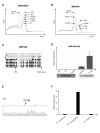Diffuse large B-cell lymphoma with combined TP53 mutation and MIR34A methylation: Another "double hit" lymphoma with very poor outcome?
- PMID: 24722400
- PMCID: PMC4039115
- DOI: 10.18632/oncotarget.1877
Diffuse large B-cell lymphoma with combined TP53 mutation and MIR34A methylation: Another "double hit" lymphoma with very poor outcome?
Abstract
MiR34A, B and C have been implicated in lymphomagenesis, but information on their role in normal CD19+ B-cells (PBL-B) and de novo diffuse large B-cell lymphoma (DLBCL) is limited. We show that in normal and activated B-cells miR34A-5p plays a dominant role compared to other miR34 family members. Only miR34A-5p is expressed in PBL-B, and significantly induced in activated B-cells and reactive lymph nodes. In PBL-B, the MIR34A and MIR34B/C promoters are unmethylated, but the latter shows enrichment for the H3K4me3/H3K27me3 silencing mark. Nine de novo DLBCL cases (n=150) carry both TP53 mutation and MIR34A methylation ("double hit") and these patients have an exceedingly poor prognosis with a median survival of 9.4 months (P<0.0001), while neither TP53 mutation, MIR34A or MIR34B/C promoter methylation alone ("single hit") influence on survival. The TP53/MIR34A "double-hit" is an independent negative prognostic factor for survival (P=0.0002). In 2 DLBCL-cell lines with both TP53 mutation and promoter methylation of MIR34A, miR34A-5p is upregulated by 5-aza-2'deoxycytidine. Thus, the TP53/MIR34A "double hit" characterizes a very aggressive subgroup of DLBCL, which may be treatable with epigenetic therapy prior to or in combination with conventional immunochemotherapy.
Figures





References
-
- Alizadeh AA, Eisen MB, Davis RE, Ma C, Lossos IS, Rosenwald A, Boldrick JC, Sabet H, Tran T, Yu X, Powell JI, Yang L, Marti GE, Moore T, Hudson J, Lu L, et al. Distinct types of diffuse large B-cell lymphoma identified by gene expression profiling. Nature. 2000;403:503–511. - PubMed
-
- Hans CP, Weisenburger DD, Greiner TC, Gascoyne RD, Delabie J, Ott G, Müller-Hermelink HK, Campo E, Braziel RM, Jaffe ES, Pan Z, Farinha P, Smith LM, Falini B, Banham AH, Rosenwald A, et al. Confirmation of the molecular classification of diffuse large B-cell lymphoma by immunohistochemistry using a tissue microarray. Blood. 2004;103:275–282. - PubMed
-
- Grønbæ K, Brown PDN, Møller MB, Nedergaard T, Ralfkiaer E, Møller P, Zeuthen J, Guldberg P. Concurrent disruption of p16 INK4a and the ARF-p53 pathway predicts poor prognosis in aggressive non-Hodgkin ' s lymphoma. Leukemia. 2000;14:1727–1735. - PubMed
-
- Lenz G, Wright GW, Emre NCT, Kohlhammer H, Dave SS, Davis RE, Carty S, Lam LT, Shaffer AL, Xiao W, Powell J, Rosenwald A, Ott G, Muller-Hermelink HK, Gascoyne RD, Connors JM, et al. Molecular subtypes of diffuse large B-cell lymphoma arise by distinct genetic pathways. Proc Natl Acad Sci U S A. 2008;105:13520–13525. - PMC - PubMed
-
- Tagawa H, Suguro M, Tsuzuki S, Matsuo K, Karnan S, Ohshima K, Okamoto M, Morishima Y, Nakamura S, Seto M. Comparison of genome profiles for identification of distinct subgroups of diffuse large B-cell lymphoma. Blood. 2005;106:1770–1777. - PubMed
Publication types
MeSH terms
Substances
LinkOut - more resources
Full Text Sources
Other Literature Sources
Research Materials
Miscellaneous

